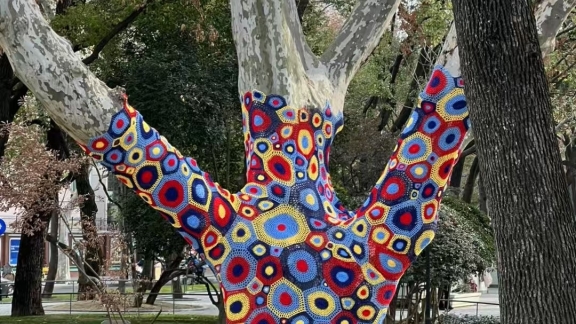
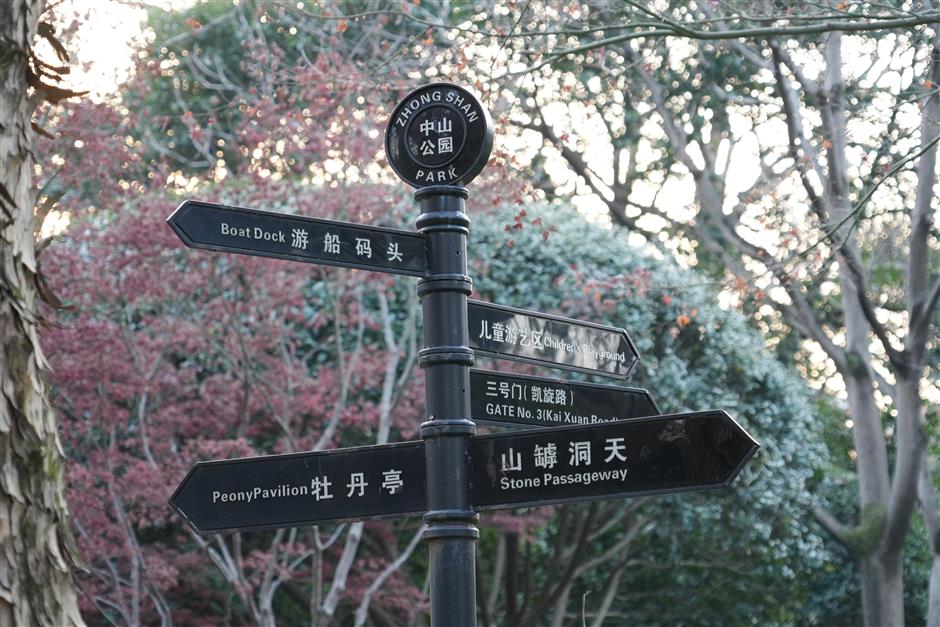
Signs point your way inside Zhongshan Park.
An urban park, like an oasis of spirituality, refreshes a weary soul. Downtown Zhongshan Park may have an answer to how this magic works.
The park is typically English pastoral and features vast grasslands, oaks and locust trees, creeks and ponds.
The south entry of the park leads to a spacious sycamore tree forest, with their silver trunks towering into the sky and leaves in wintry weather turning reddish brown. Three bronze-colored sculptures – featuring three men in a row seeming to look and anticipate, a couple doing the tango, a family waltzing – circle the forest in the north, south and west corners.
They occasionally attract a toddler to approach and peek into their patterns.

The bronze-colored sculptures at Zhongshan Park.
The area used to be vast farmland and a graveyard, with only a village named Wujiazhai along the Wusong River, now Suzhou Creek, in the east of St John's University, now a campus of East China University of Political Science and Law.
Between 1860 and 1862 a road named Jessfield Road, now Wanhangdu Road, was paved to connect Jing'an Temple with Caojiadu Town.
Briton James Hogg and his brother Hayes purchased land on both sides of the road and built private garden to the south. They named it after their trading company Co Brother' Hogg. It's Chinese name was Zhaofeng 兆丰 as in "ruì xuě zhào fēng nián 瑞雪兆丰年," which means, a timely snowfall gives promise of a fruitful year.
In 1913 the need for a public sports ground in the west of Shanghai arose for the purpose of training patrols and foreign navy personnel. After an additional planting of grassland, roses and more vegetation, and some assemblage of rockery stones, the prototype of Zhongshan Park officially opened as Zhaofeng Park.
A large proportion of its vegetation was imported from the West.
The northwest corner of the park still has one London plane tree, which the British merchant and landscaper Thomas Hanbury (1832-1907) imported from Italy to Shanghai as a gift for Hogg. The tree with its towering silhouette, thick trunk and stretching canopy has a history of more than 150 years.
Historically nicknamed by expats in Shanghai as their "Far East Home Botanic Garden," Zhaofeng Park once aspired to become the world's biggest and most interesting Chinese plantation garden with its greenery trimmed and restored every year.
The park still has a Chinese floss silk tree that dates from 100 years ago.
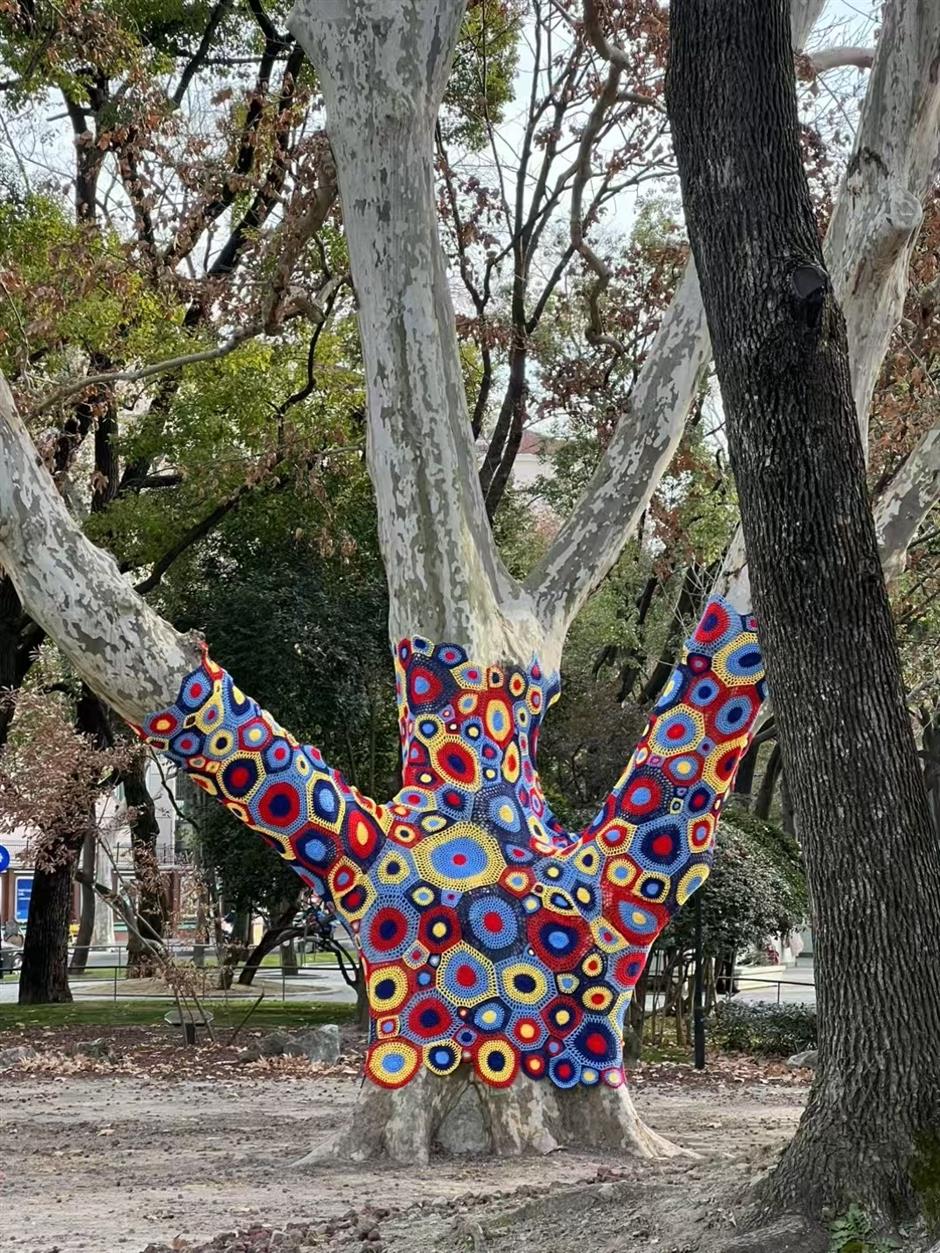
The London plane tree
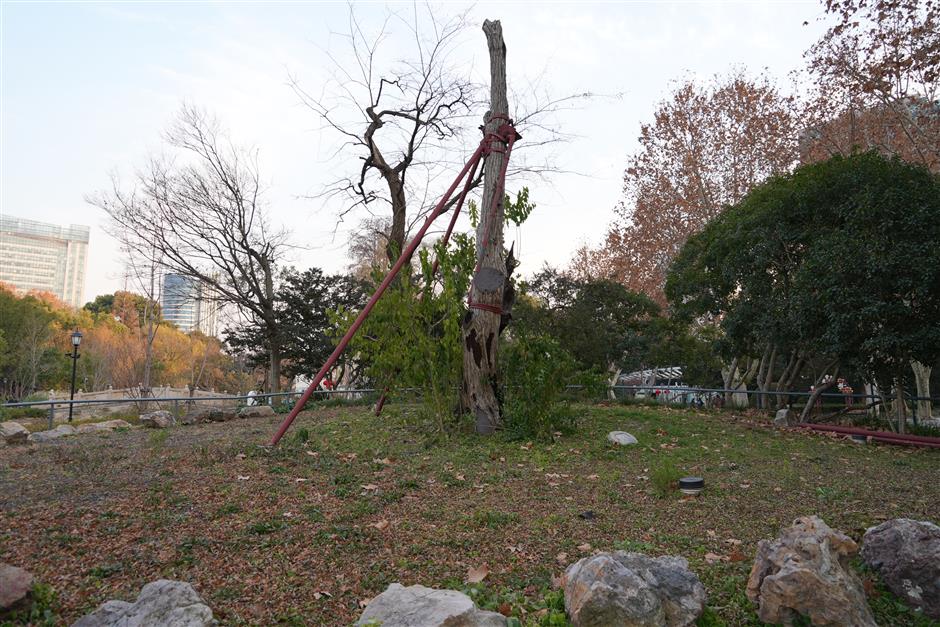
The century-old Chinese drunken tree in Zhongshan Park, numbered as 1772 Euonymus L., is 10.7 meters tall and 2.85 meters in diameter.
Zhongshan Park at 780 Changning Road can be approached from Metro Line 2's Zhongshan Park Station or across Yuyuan Road from the Jiangsu Road Station.
On a sunny weekend the park is an inspiration for people to engage into all kinds of activities.
They fly model planes or frisbees, picnic in the park's six grasslands, play ball games, or kick shuttlecocks.
A marble stone clearing in front of a Roman marble stone pavilion is a favored ground for a group shuttlecock games.
Men and women with a knack for sports stand at four corners of a rectangular pattern. They relay their shuttlecocks diagonally or face-to-face with an energetic kick.
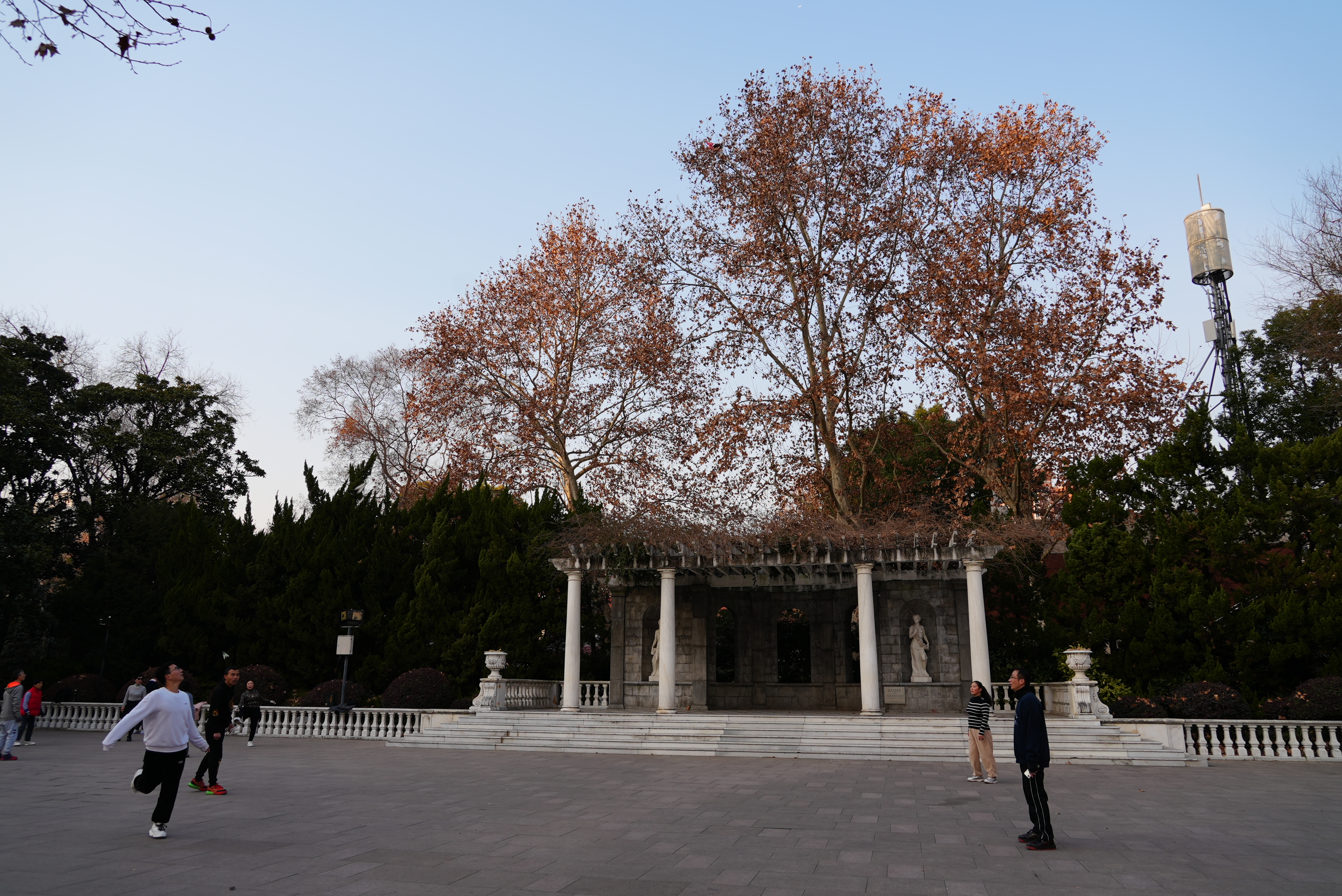
-

Men and women play shuttlecock in a group.
-
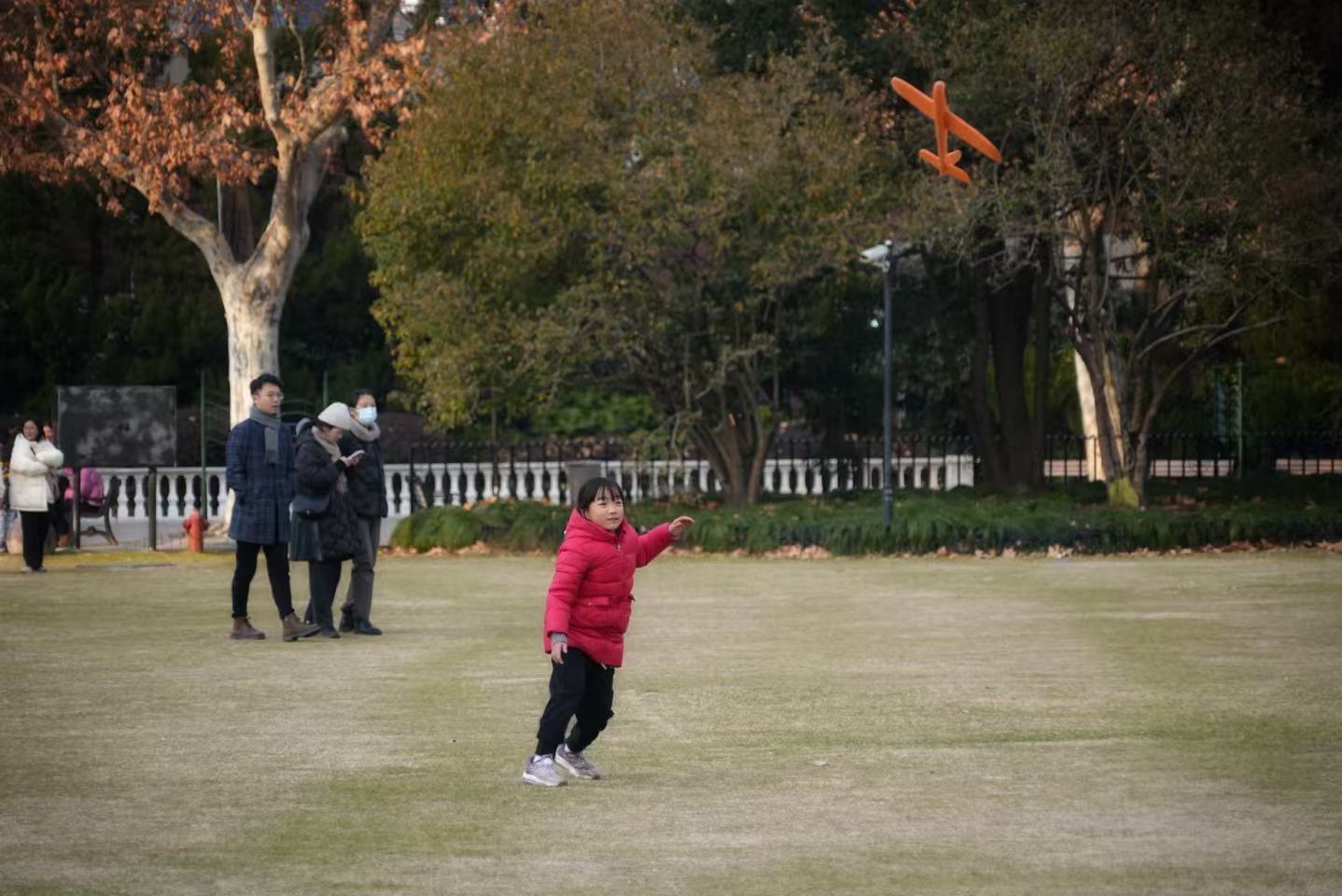
A kid throws a plane model.
-

A father instructs his daughter before a ball game.
SHINE -

"Now everybody knows you're 25-year-old."
SHINE -

People play saxophones.
SHINE -

People chat and rest inside a stone pavilion.
SHINE -

It might feel good to play football with barefeet on a grassland.
SHINE
The marble stone pavilion behind them was a donation from expat Edward Ezra in the 1930s. In 1935 Ezra funded the construction of the ancient Roman Peristyle architecture in the north of the eastern grassland of Zhaofeng Park.
The rectangular marble stone pavilion is supported by four Tuscan columns in its façade, with two rows of vase-style parapets and a pair of Western stone vases unfolding behind.
Inside the pavilion, two goddess statues, one holding a flower band and the other circled by fruit, suggesting good omens for harvest, are carved in its niches.
The pavilion took the place of an outdoor band stand in the northeast of the park, for holding orchestra performances every Saturday afternoon and Sunday morning.
Displaced people and music lovers from Germany, Austria, Poland, Czech and other European countries who resettled themselves in Shanghai after World War II were regular attendees.
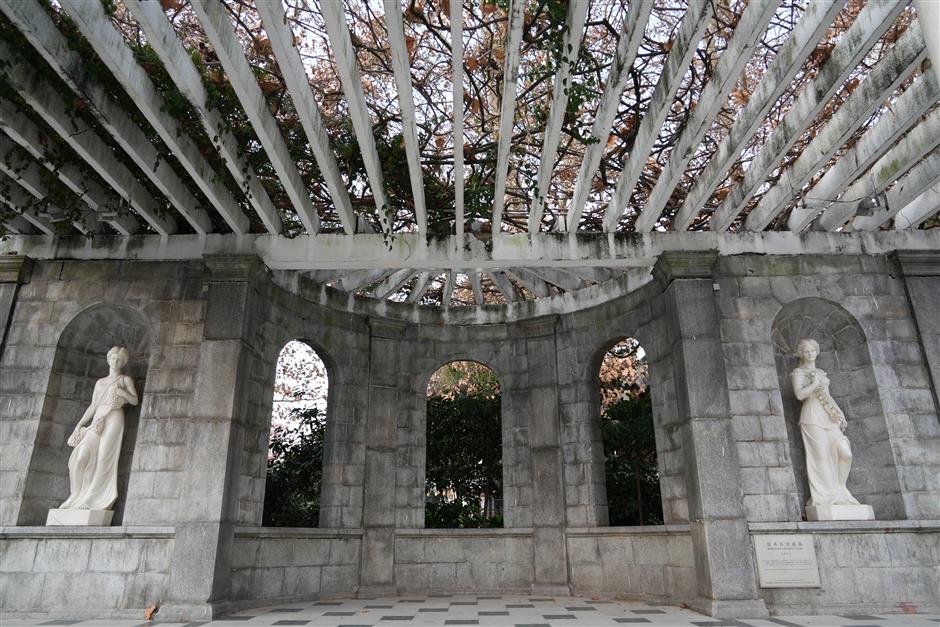
Wisteria vines on top of the Roman Peristyle marble pavilion.
The eastern meadow is the largest of the six grasslands in Zhongshan Park. It is surrounded by oleander, camphor, Southern magnolia, Chinese torreya, pine, bamboo and gingko forests. Its graceful contours reminded one visitor of the Great Lawn of London's Hyde Park.
In spring 2007 the eastern meadow welcomed a "foreign guest," a bronze statue of the Polish composer and pianist Frédéric Chopin (1810-1849).
The statue is seven meters high and weighs 2.5 tons, making it the tallest monument to Chopin in the world. Rectangular poles of different heights, widths and positions stand above the ground, resembling piano keys.
Alongside is a dry weeping willow, symbolic of Polish rural scenery.
Chenjiachi Lake is situated in the east of Zhongshan Park. A marble bridge crosses the lake and links the east part of the park. In the north of the bridge is an isle on the lake.
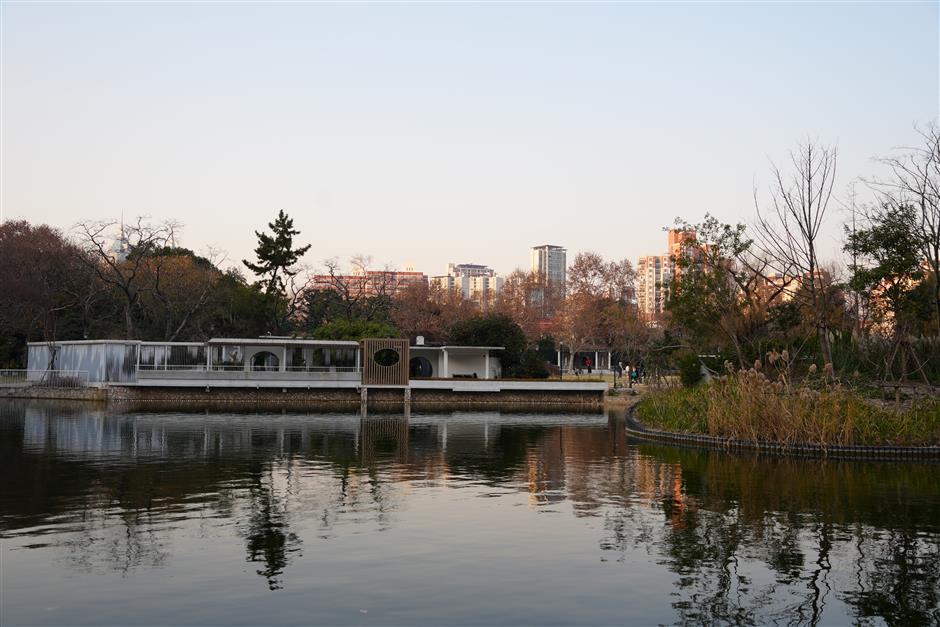
Sunset at Chenjiachi Lake.
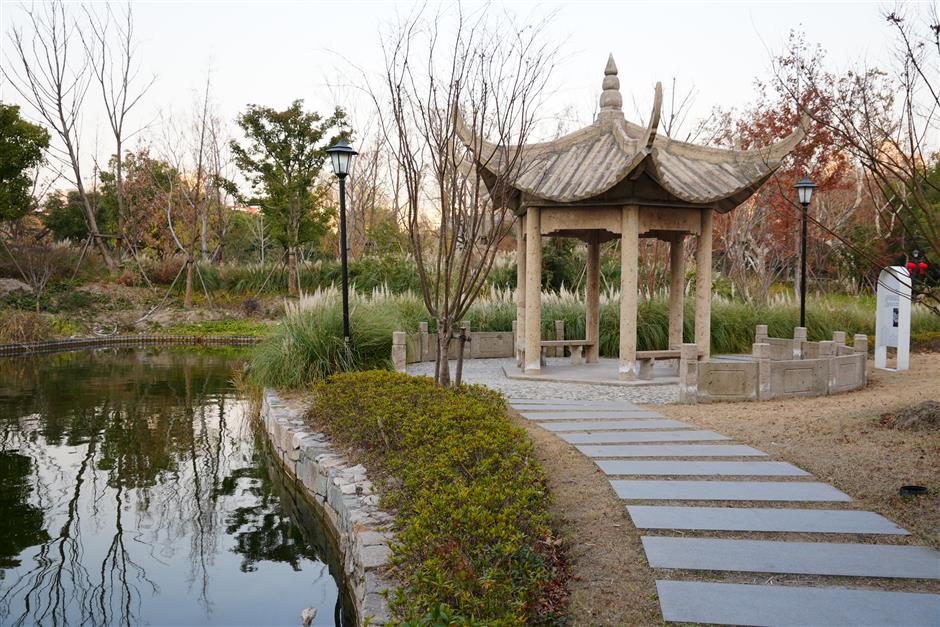
The stone pavilion at Chenjiachi Lake.
A river used to run east-west in the central area of the park. By 1948 its course was silted and a drain was paved underneath. The next year the river was assigned into the domain of the park and became what we see now as the Dry Bridge of Zhongshan Park.
Another bridge, in the west of the park, is said to be the Xianghua Bridge relocated from the legendary Fahua Temple of Fahua Town in Shanghai old town in the 1950s.

A visitor plays flute underneath the Dry Bridge.
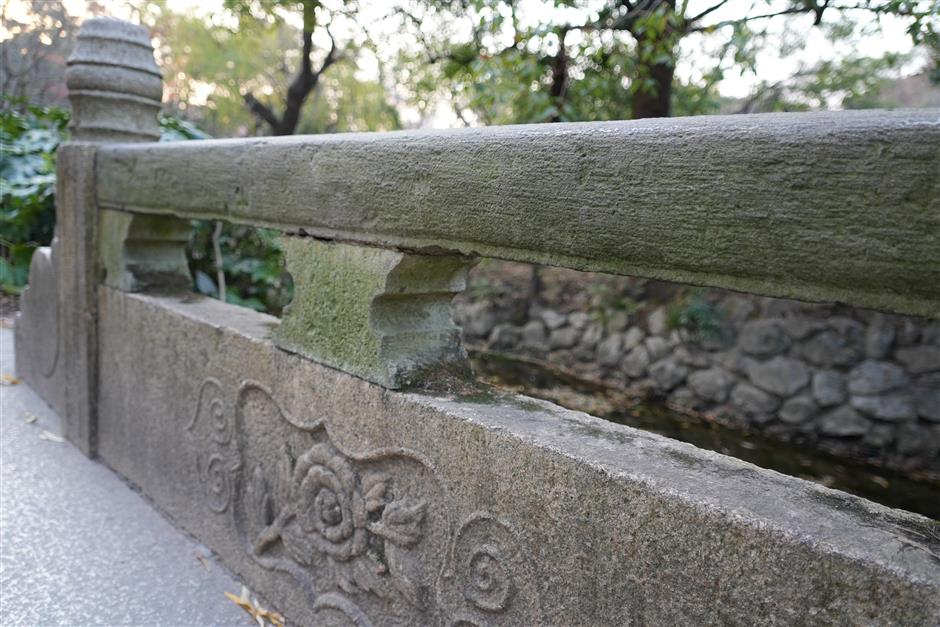
Xianghua Bridge in Zhongshan Park.
In the Rose Garden in the southern end of the park, there is a delicately-carved animal statue that used to be part of a sundial. It has a head resembling a dragon, a body resembling a Chinese unicorn, a pair of feet resembling cow hooves and two unfolding wings.
A bronze bell near the east meadow of the park is another reminder of past noise and fury.
In 1881 a 4ft bronze bell weighing two and a half tons arrived in Shanghai from New York. It was the earliest fire alarm clock in Shanghai at a fire condition observatory.
In 1922 the bell was transferred to Zhongshan Park. The current bell is an exact replica made in 2013 of the original.
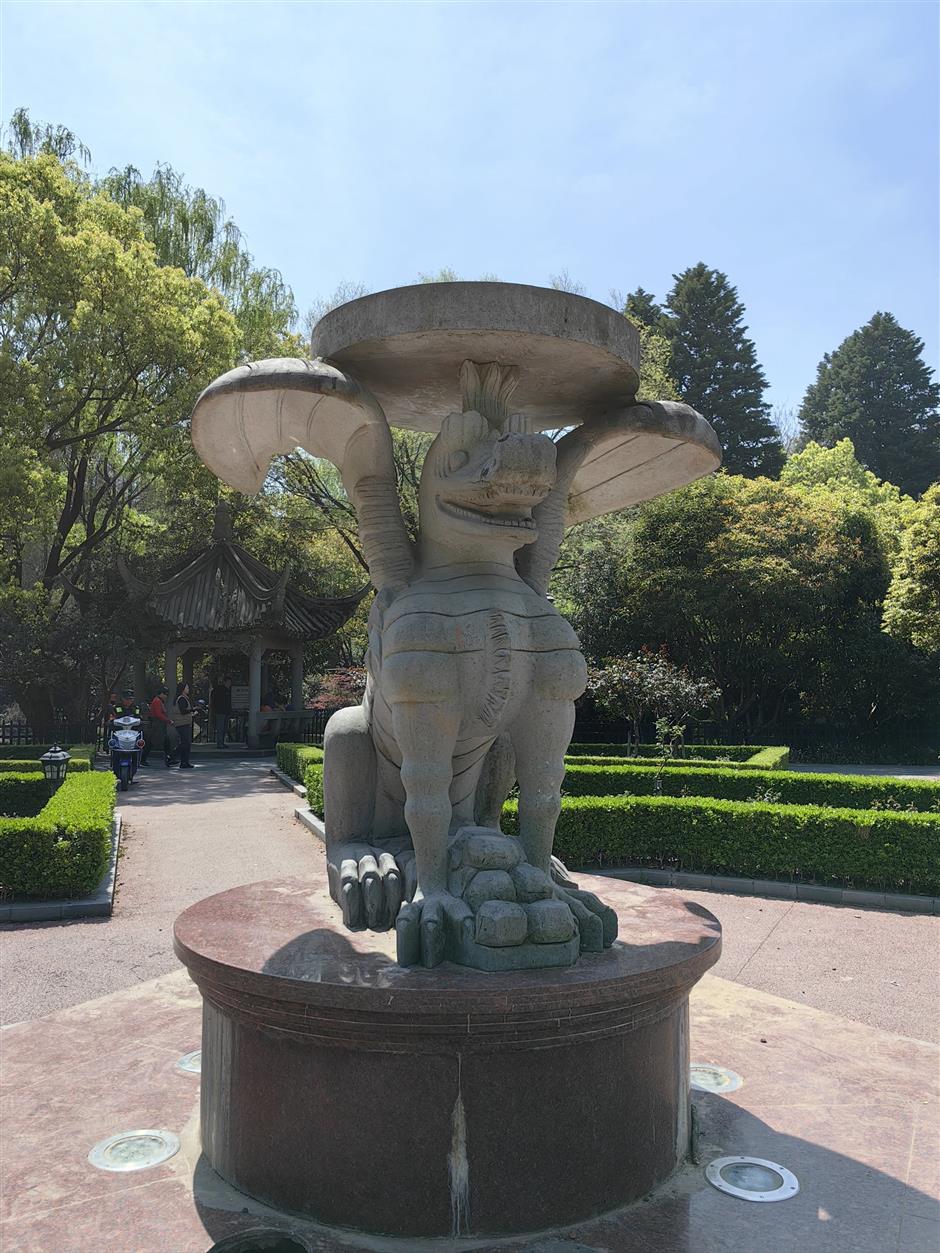
The "Neither Fish Nor Fowl" animal statue inside Zhongshan Park.
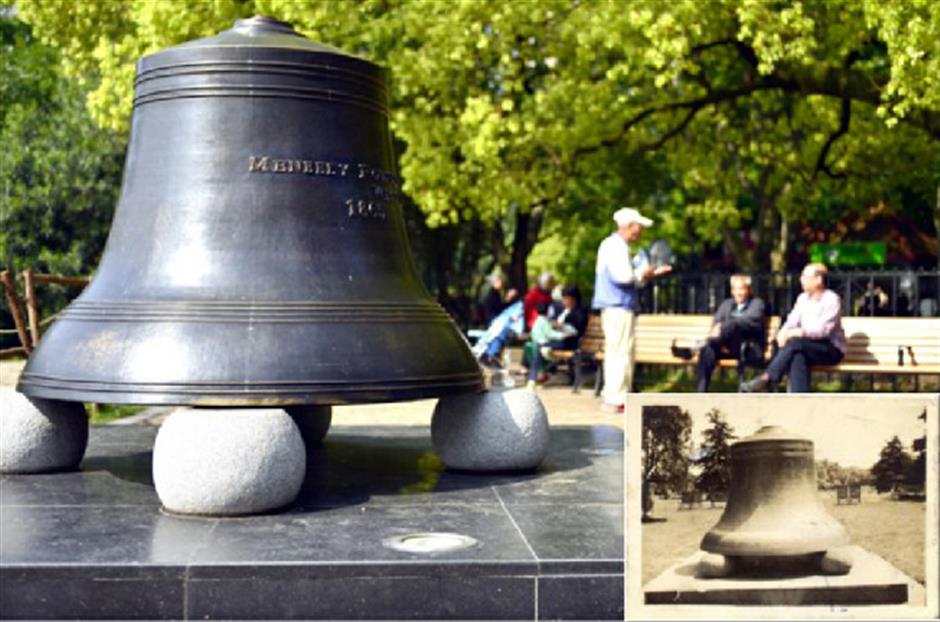
A bronze bell that is the exact replica of the earliest fire warning bell in Shanghai.
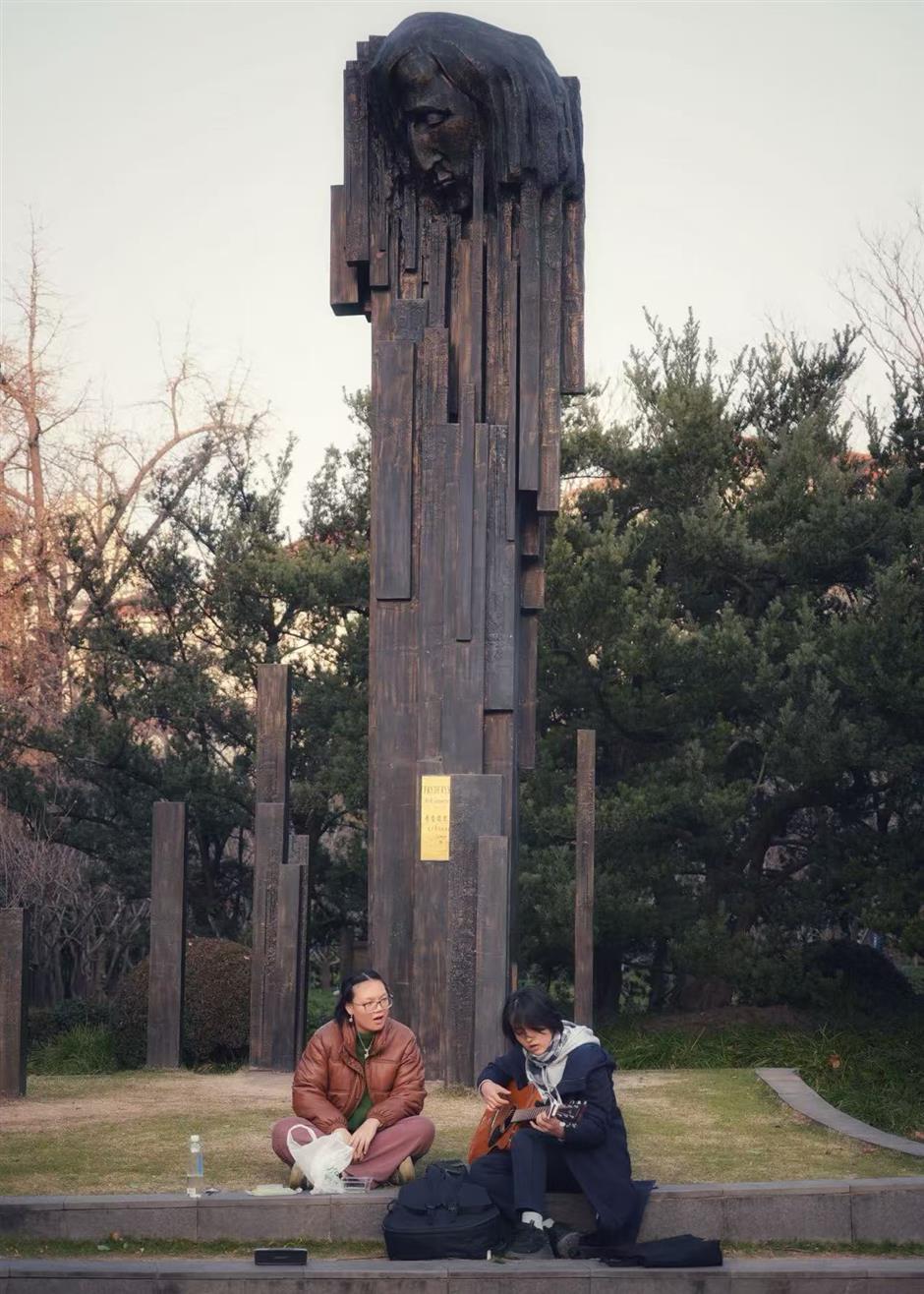
A guitarist plays in front of a sculpture in memory of Chopin.
Zhongshan Park
Brief: Zhongshan Park was once the private garden of Briton James Hogg. Previously Zhaofeng Park, it was renamed Zhongshan Park in 1944 in memory of the revolutionary father Sun Yat-sen (1866-1925). One of its gates is still in the original British style when the park first opened in 1914. The park is also noted for its Chinese roses and peony flower blossoms.
Opening hours: Round the clock
Suggested hours for touring: 1-2 hours
Ticket: Free
How to get there: Get off at Metro Line 2 Zhongshan Park Station
Address: 780 Changning Rd, Changning District
长宁区长宁路780号
If you go:
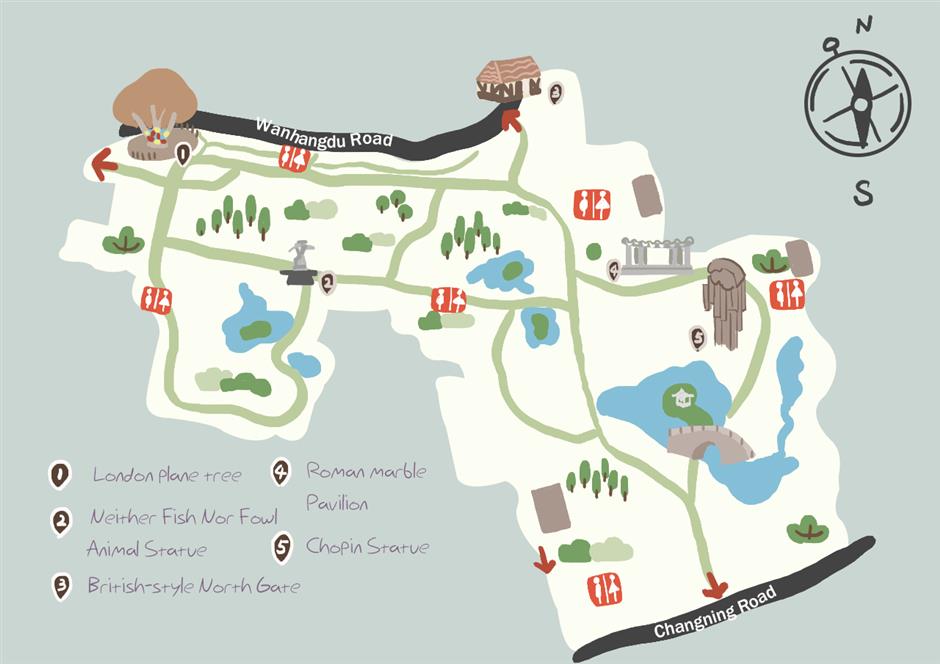
Illustration by Yang Yang

